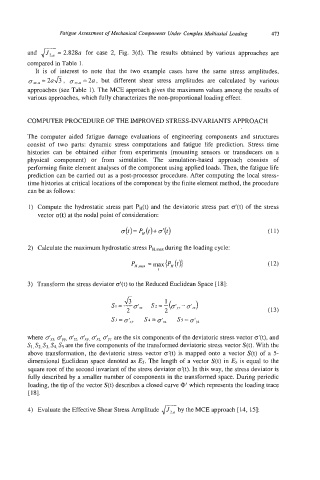Page 489 - Biaxial Multiaxial Fatigue and Fracture
P. 489
Fatigue Assessment of Mechanical Components Under Complex Multiaxial Loading 473
and = 2.828~ for case 2, Fig. 3(d). The results obtained by various approaches are
compared in Table 1.
It is of interest to note that the two example cases have the same stress amplitudes,
an,a 2a&, ax),u 2a, but different shear stress amplitudes are calculated by various
=
=
approaches (see Table 1). The MCE approach gives the maximum values among the results of
various approaches, which fully characterizes the non-proportional loading effect.
COMPUTER PROCEDURE OF THE IMPROVED STRESS-INVARIANTS APPROACH
The computer aided fatigue damage evaluations of engineering components and structures
consist of two parts: dynamic stress computations and fatigue life prediction. Stress time
histories can be obtained either from experiments (mounting sensors or transducers on a
physical component) or from simulation. The simulation-based approach consists of
performing finite element analyses of the component using applied loads. Then, the fatigue life
prediction can be carried out as a post-processor procedure. After computing the local stress-
time histories at critical locations of the component by the finite element method, the procedure
can be as follows:
1) Compute the hydrostatic stress part PH(t) and the deviatoric stress part o'(t) of the stress
vector o(t) at the nodal point of consideration:
a(t) = P" (f). O'(f)
2) Calculate the maximum hydrostatic stress PH,,,,~ during the loading cycle:
3) Transform the stress deviator o'(t) to the Reduced Euclidean Space [ 181:
J5 1
SI =- s2 = -(dn - 0'22)
2 2
where dn, dyy, dZ, dq, dxL dyz are the six components of the deviatoric stress vector o'(t), and
SI, Ss, S3, S4, Ss are the five components of the transformed deviatoric stress vector S(t). With the
above transformation, the deviatoric stress vector o'(t) is mapped onto a vector S(t) of a 5-
dimensional Euclidean space denoted as E5. The length of a vector S(t) in E5 is equal to the
square root of the second invariant of the stress deviator o'(t). In this way, the stress deviator is
fully described by a smaller number of components in the transformed space. During periodic
loading, the tip of the vector S(t) describes a closed curve @' which represents the loading trace
[181.
4) Evaluate the Effective Shear Stress Amplitude by the MCE approach [ 14, 151:

